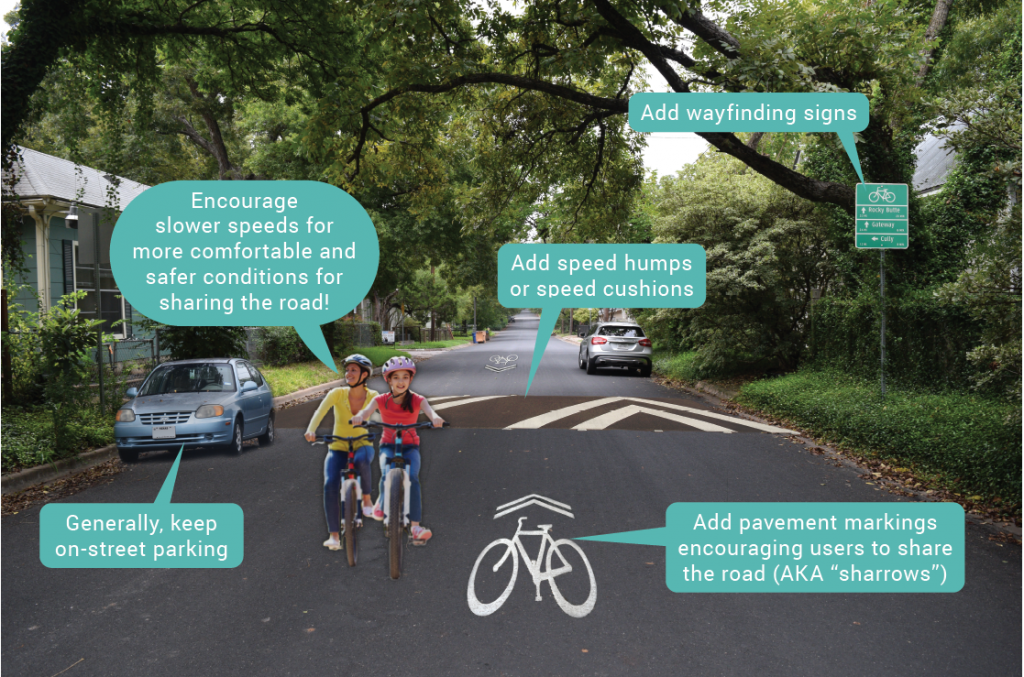Neighborhood bikeways are local streets where motor vehicle traffic speeds and volumes are kept low to make it safer and more comfortable to bicycle, walk, and play. Neighborhood bikeways were formerly called “quiet streets” in the 2014 Austin Bicycle Plan and were renamed “neighborhood bikeways” in the Austin Strategic Mobility Plan. Neighborhood bikeways are designed to provide calm, low-stress bikeway connections within Austin's expanding All Ages and Abilities Bicycle Network. Neighborhood bikeways can enhance local streets by:
- Adding pavement markings (“sharrows”) to alert people driving to expect people bicycling in the street and help to guide people along the bikeway route
- Improving crossings of major streets
- Adding wayfinding signage to guide people to local and regional destinations
- Managing vehicle speeds and volumes
Las ciclovías del vecindario son calles con velocidades y volúmenes de tráfico de vehículos de motor más bajos donde la seguridad y la comodidad de las personas que andan en bicicleta, caminan y juegan en la calle es una prioridad. Los proyectos de ciclovías del vecindario pueden incluir marcas en el pavimento para alertar a las personas que conducen que deben esperar gente andando en bicicleta, intersecciones mejoradas de las calles principales, señales para guiar gente en bicicleta a destinos locales y regionales, y herramientas de reducción de velocidad (como topes o reductores de velocidad).

Concept for a neighborhood bikeway / Ciclovías del vecindario.
Projects:
- 46th-47th Streets and Bennett-Middle Fiskville neighborhood bikeways
- Cherrywood neighborhood bikeways
- North University-Heritage-Rosedale neighborhood bikeways
- Romeria Drive (Burnet Rd. to Lamar Blvd.)
Frequently Asked Questions
- What are neighborhood bikeways?
-
Neighborhood bikeways are one of the four types of “all ages and abilities” bicycle facilities that make up Austin’s All Ages and Abilities Bicycle Network. On neighborhood bikeways, people biking can ride comfortably in the center of the street.
Neighborhood bikeways are designed for safe and comfortable walking and playing, as well as bicycling. These streets have low motor vehicle traffic volumes and slow speeds. Neighborhood bikeways can include:
- Speed management tools such as bicycle-friendly speed humps, bicycle-friendly speed cushions, on-street parking, and curb extensions
- Volume management tools such as traffic diverters
- Wayfinding features such as pavement markings and signage to help navigate the bikeway route
- Crossing improvements such pedestrian and/or bicycle signals, crossing islands, and crosswalks
- How are neighborhood bikeway routes chosen?
-
Austin Transportation considers many factors when choosing which streets are recommended to become neighborhood bikeways. These factors include:
- Connections to existing bicycle facilities (other neighborhood bikeways, protected bike lanes, or urban trails)
- Connections to local destinations (schools, parks, businesses, etc.)
- Street widths
- Motor vehicle volumes
- Motor vehicle speeds
- Presence of hills or steep inclines
- Directness of potential routes
- Why are motor vehicle speed and/or volume reductions desired for neighborhood bikeway routes?
-
National best practices recommend that neighborhood bikeway routes have fewer than 1,500 motor vehicle trips a day and vehicle speeds at or below 25 mph depending on the route’s context. Austin Transportation strives to achieve vehicle speeds at or below 20 mph on our neighborhood bikeways. As part of Austin’s All Ages and Abilities Bicycle Network, neighborhood bikeway routes are intended to provide low-stress experiences for people bicycling. Lower motor vehicle volumes and speeds allow people biking and walking along a street (including children and older adults) to feel comfortable and safe.
- Why are neighborhood bikeways proposed instead of painted or protected bicycle lanes?
-
Painted bike lanes are not a part of Austin’s All Ages and Abilities Bicycle Network. Austin Transportation considers many factors when determining whether to propose a neighborhood bikeway or protected bicycle lane on streets that make up this network. National best practices recommend that the most appropriate bicycle facility for a street be chosen based on the unique street’s characteristics.
Streets where Austin Transportation proposes neighborhood bikeways usually have some of the following characteristics OR could have these characteristics if speed management tools, volume management tools, wayfinding features, and/or crossing improvements are installed:
- Fewer than 1,500 motor vehicle trips a day
- Vehicle speeds at or below 25 mph (with a goal of 20 mph)
- Narrow street widths
- On-street parking
Streets where Austin Transportation proposes protected bicycle lanes usually have some of the following characteristics:
- More than 1,500 motor vehicle trips a day
- Vehicle speeds above 20 mph
- Motor vehicle congestion, especially at peak hours
- Turning conflicts
- High curbside activity (a mix of uses along the street - not strictly residential

